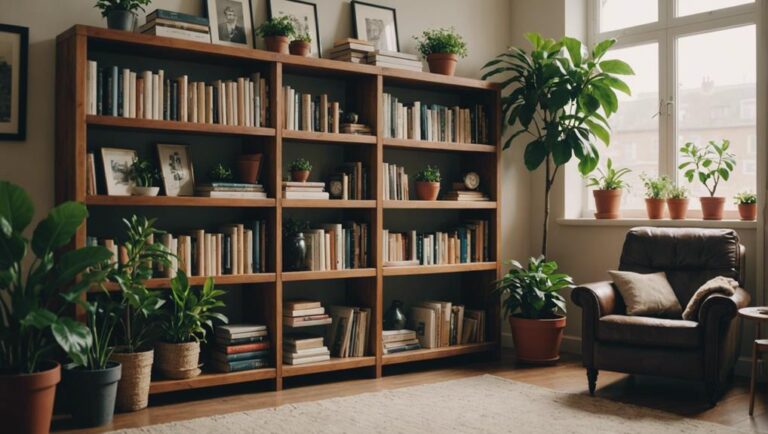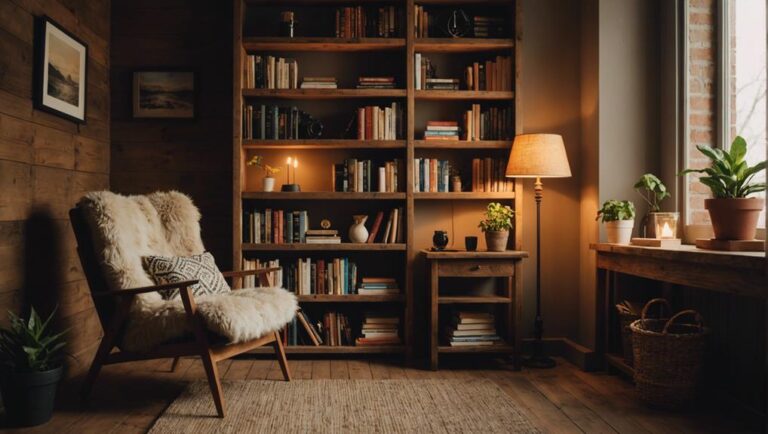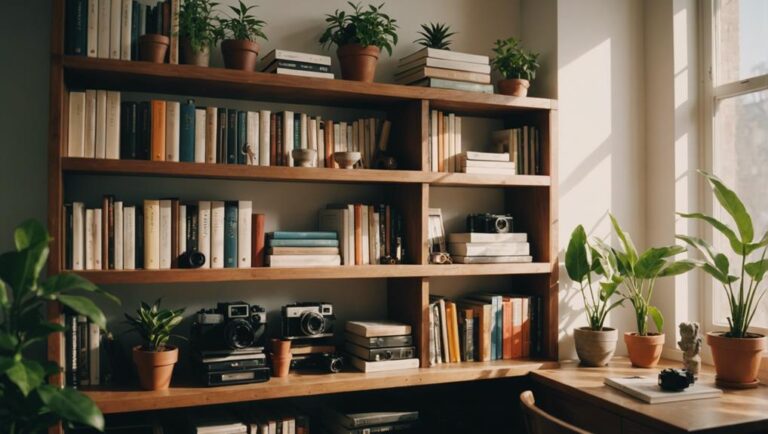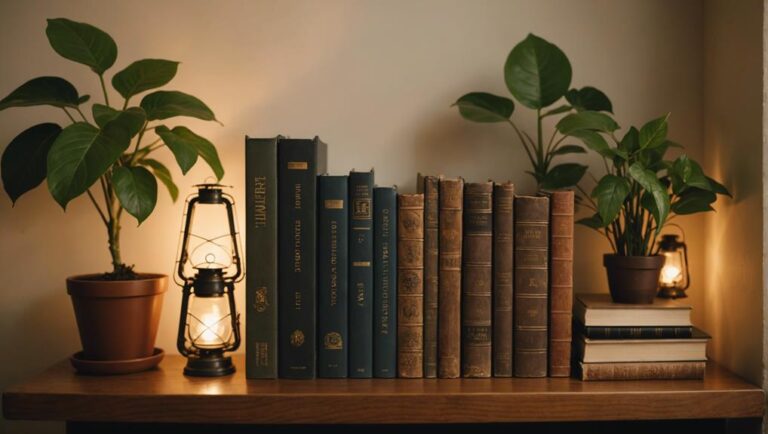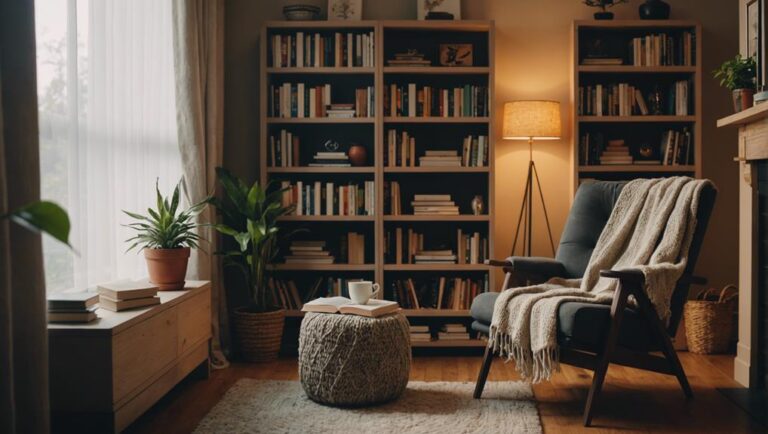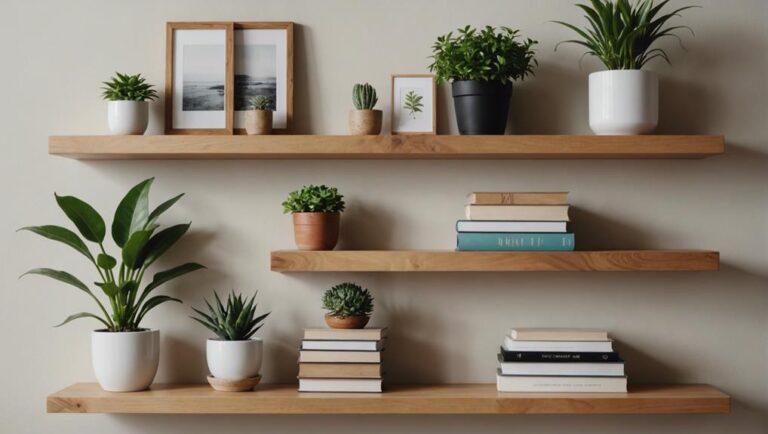Maximizing Vertical Space With Floating Wood Shelf Book Displays
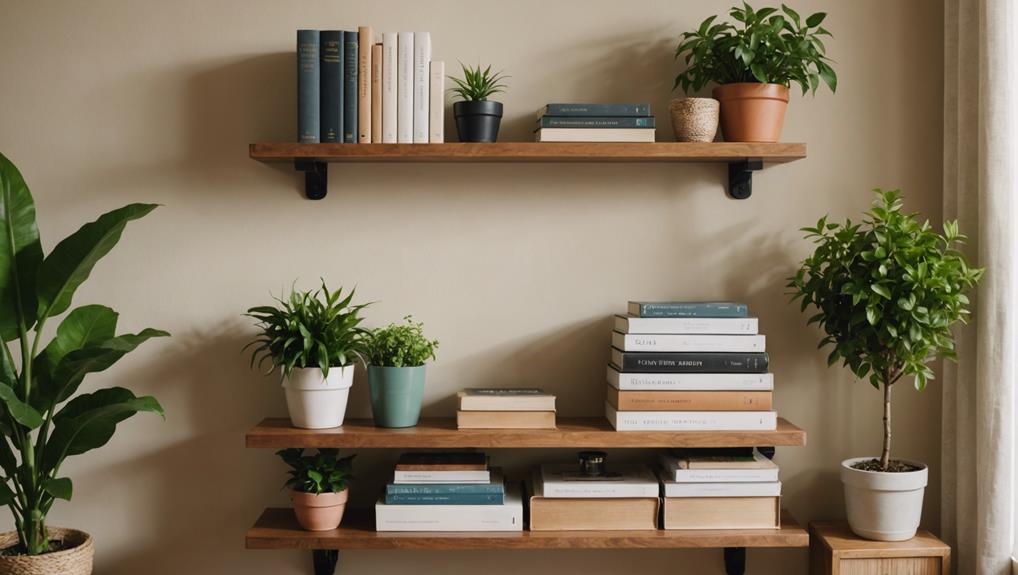
Maximizing vertical space with floating wood shelf displays offers a practical and stylish solution for organizing your books. These shelves, with their hidden mounting hardware, exude a sleek and modern aesthetic while being able to support up to 50 lbs per stud.
Opt for sturdy wood options like walnut, oak, or cherry to enhance durability and showcase unique grain patterns.
Positioning the shelves at eye level and ensuring secure installation methods will showcase your book collection elegantly, creating a focal point in any room.
By utilizing the right tools and materials, transforming a space into a functional and sophisticated book display becomes a seamless task.
Discover more creative ideas for incorporating floating wood shelves into your home decor.
Key Takeaways
- Install floating shelves strategically at different heights to create an organized and visually appealing book display that maximizes vertical space.
- Choose robust hardwood materials such as oak or walnut for durability and the ability to support up to 50 lbs per stud.
- Place shelves in a staggered arrangement to fully utilize the wall area and add an intriguing visual element to your book showcase.
- Ensure proper spacing between shelves, ideally 11 to 17 inches apart, to accommodate various book sizes and enhance the functionality of the display.
- Enhance the overall look by incorporating decorative items like plants and photos to bring balance and cohesiveness to the arrangement.
Benefits of Floating Shelves
Floating shelves are a popular choice for maximizing vertical space and adding a modern touch to any room. They offer practical solutions for storage without taking up valuable floor space, keeping rooms feeling open and uncluttered. The concealed mounting hardware of floating shelves gives them a sleek, clean appearance that seamlessly integrates with any decor style, merging form and function seamlessly.
These shelves aren't just aesthetically pleasing; they're also incredibly sturdy, capable of holding up to 50 lbs per stud. This makes them perfect for showcasing favorite books and decor items. With various depths available, such as the ideal 10 inches for holding books, floating shelves offer versatility to customize shelving to fit specific needs. Placing these shelves at eye level can create a focal point that adds visual interest and elevates the overall aesthetic of the room.
In the realm of floating wood shelf decor, utilizing books as a focal point can add a touch of sophistication and intellectual charm to any space. By displaying a curated selection of books on floating shelves, not only can you showcase your literary tastes but also create a cozy and inviting atmosphere. Whether arranging books by color, size, or genre, the possibilities for creating an eye-catching book display are endless.
Furthermore, incorporating small decorative elements, such as potted plants, framed photos, or unique trinkets, alongside books on floating shelves can add layers of visual interest and personalization to the space. Mixing textures and colors can create a dynamic and visually appealing display that reflects your personality and style. Floating wood shelves provide a versatile canvas for expressing creativity and enhancing the overall ambiance of a room.
Choosing the Right Wood
When choosing the perfect wood for our floating shelves, we should consider walnut, oak, and cherry for their durability and stunning appearance.
Each type of wood has its own distinct grain patterns and hues, allowing us to seamlessly blend them with our existing decor.
It's essential to also take into account the weight capacity of the shelves and ensure that the wood is properly treated and sealed to prevent any warping over time.
Types of Wood
When it comes to choosing the perfect wood for our floating shelves, it's crucial to understand the distinct qualities of options like oak, walnut, pine, and mahogany. Each type of wood brings its own unique charm and functionality, elevating our spaces into trendy and innovative havens. Oak stands out for its strength and striking grain patterns, making it a versatile choice that complements both classic and modern aesthetics. Its durability ensures that our floating shelf can support even the heaviest items.
Walnut, with its deep, luxurious color, adds a touch of warmth and sophistication to any room. It's an excellent choice for those aiming to introduce a lavish feel into their decor. On the other hand, pine is a cost-effective option recognized for its light color, which can be easily stained or painted to match various styles, making it highly adaptable.
Then there's mahogany, the top-tier pick, known for its rich reddish-brown hue and graceful appearance. It's perfect for creating a polished and upscale ambiance. Here's a brief comparison to help us visualize these choices:
| Wood Type | Color | Characteristics |
|---|---|---|
| Oak | Light to medium | Strong, prominent grain patterns |
| Walnut | Dark brown | Warm, sophisticated, luxurious |
| Pine | Light | Budget-friendly, easily customizable |
| Mahogany | Reddish-brown | Premium, elegant, upscale |
Selecting the right wood ensures that our floating shelves not only make the most of vertical space but also enhance our interior design with flair and practicality.
Wood Durability Factors
Let's delve into how wood durability factors such as hardness, density, and grain pattern impact our selection of the perfect floating shelves. When it comes to floating shelves, choosing the right wood is crucial for both function and longevity.
Hardwoods like oak, maple, and cherry are known for their exceptional hardness and density, ensuring they can bear heavy loads without bending or warping. These characteristics make them ideal for sturdy, enduring floating wood shelves.
On the other hand, softwoods like pine and cedar, though less durable, offer a lightweight option. With the application of finishes and sealants, they can be strengthened to prolong their lifespan, making them suitable for specific uses.
Exotic woods like mahogany and teak are celebrated for their high durability and distinct grain patterns, contributing strength and visual charm to floating wood shelves.
Engineered woods like MDF and plywood offer cost-effective and stable choices. Their consistent density and resistance to warping make them particularly fitting for constructing floating shelves, especially in contemporary and simplistic designs.
Aesthetic Wood Choices
When selecting the perfect wood for our floating shelves, we must consider the balance between durability and visual appeal. Walnut wood stands out for its natural beauty and deep tones, offering both a sturdy structure and a striking appearance. Its rich, dark hues and intricate grain patterns make it a standout choice for those seeking a bold and elegant statement in their book display.
On the other hand, oak wood exudes a timeless and classic charm. Its diverse grain patterns allow for customization to complement any decor style, whether rustic or modern. The strength of oak ensures that our floating shelves will remain sturdy and reliable over time, adding a touch of sophistication to our book collection.
For a warm and refined finish, cherry wood proves to be an excellent choice. Its reddish-brown color deepens with age, enhancing the overall aesthetic of our space with a hint of luxury.
Maple wood, with its light color and smooth texture, offers versatility for contemporary designs, creating a clean and sleek look for our book display.
Lastly, mahogany wood radiates luxury and sophistication with its deep, reddish-brown tones and fine grain. It's an ideal option for adding an elegant touch to our floating shelf book display. By carefully selecting the right wood type, we can achieve a perfect balance of beauty and functionality in our home decor.
Ideal Shelf Placement
When deciding on the perfect spot for your floating wood shelves, aim to place them at eye level to create an attractive focal point in the room. Floating shelves are excellent for drawing attention and utilizing vertical space, which is especially beneficial in smaller rooms with limited floor space. By positioning the shelves at eye level, you establish a natural line of sight, encouraging visitors to explore your carefully curated displays of books, art, and decor.
Consider the size of the room when determining the number of shelves to install. In larger rooms, multiple shelves can make a bold statement, while smaller spaces may benefit from a more simplistic approach. Adding variety by staggering the placement of the shelves can enhance visual appeal and prevent a dull, uniform look, making the display more dynamic and engaging.
Remember to use a level during the installation process to ensure that each shelf is perfectly straight, creating a polished and professional appearance.
Don't forget about utilizing corner spaces, as these often-overlooked areas can offer additional storage and display options without overwhelming the room. By carefully considering the placement of your floating wood shelves, you can elevate any space with functional and visually pleasing decor.
Tools and Materials
When installing floating wood shelves for a stylish book display, it's essential to have the right tools and materials on hand. A sturdy ladder, tape measure, stud finder, drill, anchors, wood screws, laser level, and carpenter's square are crucial for ensuring the stability and safety of your shelves. These tools will help you maximize your storage space efficiently and securely.
Choosing high-quality materials like walnut wood is key to not only durability but also adding a touch of elegance to your living space. The type of wood you select directly impacts the weight capacity and overall look of your shelves, so investing in quality materials is a wise decision from the outset.
By using the proper tools and materials during installation, your floating wood shelves won't only look fantastic but also withstand the test of time. This focus on quality ensures a visually appealing and functional book display that showcases your collection beautifully.
Paying attention to both tools and materials in the installation process is essential for creating an innovative and long-lasting storage solution.
Measuring and Marking
Accurate measuring and marking play a crucial role in ensuring the proper installation and stability of your floating wood shelves for displaying books. Start by using a tape measure to determine the ideal height and width of your shelves. This precision in measurement is essential for creating an innovative and functional book display.
Once you have the measurements, mark the wall with a pencil to indicate where the shelves will be placed, keeping alignment in mind. To support the weight of your books and maintain the integrity of the shelves, it's important to consider their weight capacity. Use a stud finder to locate the necessary solid support for secure installation. This step is critical in preventing any accidents in the future.
Additionally, a laser level can help ensure that your floating shelves are perfectly straight and evenly spaced, providing a professional and refined look to your book display. Before proceeding with any drilling, it's vital to double-check all measurements and markings. This final verification step helps avoid any errors and ensures that your floating wood shelves are positioned accurately.
Mounting Techniques
Securing our floating wood shelves properly is key when creating a stunning book display. It's crucial to pay close attention to studs and wall anchors to ensure a sturdy installation.
Studs and Wall Anchors
When installing floating wood shelves for a book display, it's crucial to locate studs and utilize wall anchors correctly to ensure the shelves' stability and durability. Studs, the vertical support beams within a wall, are typically spaced 16 inches apart and offer essential support for our shelves.
By using a stud finder, we can easily pinpoint these studs hidden behind the drywall, guaranteeing a secure anchoring for our shelves.
In some cases, our shelves may not align perfectly with studs. This is where wall anchors play a vital role. Wall anchors are indispensable for mounting shelves in areas where studs aren't available, boosting stability and the weight-bearing capacity of the shelves.
Depending on their type and size, properly installed wall anchors can support up to 50 lbs per anchor, ensuring a safe and reliable installation for our book display shelves.
Bracket Placement Tips
After identifying the studs and securing wall anchors, let's now focus on placing the brackets for our floating wood shelves. The key to ensuring stability and aesthetics is to attach the brackets directly into the wall studs. This method guarantees that our shelves can support significant weight without any risk of sagging or collapsing. For optimal support, it's recommended to position the brackets closer together, distributing the weight evenly across the shelf.
When determining the placement of the brackets, it's essential to consider the length and weight of the shelf. For longer or heavier shelves, using more brackets will increase stability. A general guideline is to space the brackets every 16 to 24 inches, although adjustments can be made based on the specific requirements of the shelf. This approach won't only support our collection of books but also any decorative items we wish to showcase.
Ensuring that the brackets are horizontally aligned is crucial for achieving a balanced and visually pleasing installation. While we'll delve into leveling and alignment in the next section, remember that the accuracy of bracket placement directly impacts the overall success of our innovative shelving solution.
Leveling and Alignment
Leveling and alignment play a crucial role in ensuring our floating wood shelves aren't only functional but also visually striking. The use of a level during installation is essential for creating a straight line, preventing any tilting or uneven appearance on the wall. This step is key for achieving a balanced and aesthetically pleasing display while also ensuring the overall functionality of the shelves.
Utilizing innovative tools like laser levels can help us achieve precise placement. These devices project a straight line across the wall, making it easier to align our shelves perfectly. Accurate leveling guarantees that our book displays are stable and visually stunning, enhancing the overall design of the space.
Here's a brief overview of the tools and techniques we can utilize:
- Bubble Level: This manual alignment tool is simple and cost-effective.
- Laser Level: Projects a straight line for precise and efficient alignment.
- Measuring Tape: Useful for measuring distances and ensuring consistency.
- Spirit Level: Provides accurate readings for checking horizontal and vertical alignment.
- Mounting Brackets: Support structures that provide stability and strength to the shelves.
Shelf Spacing Guidelines
Proper spacing between floating wood shelves plays a crucial role in creating a well-balanced and visually appealing book display. Following recommended guidelines allows us to maximize vertical space and achieve an organized and attractive arrangement.
Typically, shelves should be spaced between 11 to 17 inches apart, catering to various book sizes and ensuring efficient utilization of each shelf without creating a cluttered look. For smaller books, a spacing of 11 inches provides a snug fit, maintaining a neat and tidy display. Larger or oversized books, on the other hand, require a spacing of up to 17 inches to allow ample room for showcasing their grandeur.
Adapting the spacing based on book sizes enables us to create a harmonious and aesthetically pleasing setup. Maintaining proper shelf spacing is crucial to prevent overcrowding, which can detract from the overall visual appeal of the display. Adhering to these guidelines not only enhances the functionality of the book display but also elevates its design.
Utilizing floating wood shelves to maximize vertical space ensures a perfect blend of practicality and style, making the book display a standout centerpiece in any room.
Styling Your Shelves
Decorating floating wood shelves with a mix of books, decorative objects, plants, and photos gives a unique touch to our book displays. By matching the shelf style and materials with our existing decor, we ensure a cohesive and polished look for the room. Placing shelves at eye level not only showcases the items on display but also creates a focal point that captures attention.
To create visual interest, try arranging shelves asymmetrically or in a staggered pattern. This technique adds a dynamic element to your book storage solution, breaking away from traditional symmetry. Carefully selecting and arranging items allows you to showcase your personal style and preferences. Mixing different textures, colors, and shapes can further enhance the appeal of your display.
Incorporating personal touches like cherished photos or mementos adds a sentimental value to the design, making it a true reflection of your personality.
It's essential to find a balance between functionality and aesthetics, ensuring that your shelves not only store books but also contribute to the overall decor of the room. This approach transforms your book storage into a stylish and innovative design element that enhances the visual appeal of the space.
Adding Decorative Items
By incorporating decorative items like framed photos, succulents, and vases into our floating wood shelf book displays, we can significantly enhance their visual appeal. These added accents bring a personal touch and create a cohesive look that complements the overall decor of our spaces. Mixing various textures and colors through these decorative items not only adds depth but also introduces an intriguing layer of interest that transforms a simple shelf into a captivating display.
Decorative elements such as candles, figurines, and pottery can seamlessly blend with the books on our shelves, resulting in a balanced and harmonious arrangement. Thoughtfully placing these accents helps us avoid overcrowding while maintaining a visually pleasing aesthetic. For example, positioning a small succulent between two books or placing a framed photo against the back wall can establish focal points that naturally attract the eye.
Achieving a well-rounded appearance on our floating wood shelves involves finding the right balance between books and decorative items. This equilibrium prevents the display from looking cluttered or too sparse. By carefully arranging these elements, we can elevate our shelves into stylish and functional showcases that reflect our unique style and innovative spirit.
Maximizing Storage
Decorative items add visual charm, but the real magic happens when we optimize storage with our floating wood shelves. These shelves are a game-changer for showcasing and organizing our book collections without sacrificing valuable floor space. With each shelf supporting up to 50 lbs per stud, they offer a sturdy solution for homeowners seeking to tidy up and streamline their living areas.
To maximize our vertical storage potential, we should strategically place our items on the shelves. The 10-inch depth allows for a range of book sizes while maintaining a modern and uncluttered look. Let's compare what we can achieve with floating wood shelves versus traditional cabinet space:
- Floating Wood Shelves: Can hold up to 50 lbs per stud, 10 inches deep for versatility, minimalist and open design, easy access and visibility, customizable arrangements.
- Traditional Cabinet Space: Limited by cabinet dimensions, often deeper and less efficient, enclosed and bulky design, potentially cluttered interior, fixed and less flexible layout.
Maintaining Balance
To keep our floating wood shelf book displays visually appealing and structurally sound, it's essential to pay attention to how we distribute weight. By combining both vertical and horizontal book placements, we achieve a balanced and cohesive aesthetic that also reinforces the shelves' stability. Introducing decorative elements alongside our books not only enhances the overall look but also contributes to the overall strength of the display.
Decorating floating wood shelves with a mix of books and decorative items can create a dynamic and engaging focal point in any room. The combination of functional books and visually pleasing decor adds depth and interest to the display, making it a versatile and attractive addition to your home decor.
When styling floating wood shelves, consider incorporating plants, artwork, or unique objects to create a personalized and inviting space. Mixing textures, colors, and shapes can further enhance the visual appeal of the display while maintaining a sense of balance and harmony. By experimenting with different arrangements and elements, you can create a floating wood shelf display that reflects your style and personality while also ensuring its stability and durability over time.
Proper Weight Distribution
Proper weight distribution on floating wood shelves is crucial for maintaining balance and stability. To maximize the vertical space with these chic displays, it's essential to evenly distribute the weight across the shelf surface. This not only prevents sagging or tilting but also reduces strain on the mounting hardware, ensuring long-term durability.
For a creative and balanced shelf arrangement, place heavier items like large books or decorative pieces towards the center. This strategy helps to keep the shelves steady and prevents any potential tipping. It's important to remember that each shelf has a specific weight capacity, so it's wise to be mindful of the load placed on them. Using suitable anchors and screws is imperative to securely support the total weight.
Regularly inspecting the shelves for signs of warping or bending is recommended. These issues could indicate improper weight distribution and serve as an early warning to rearrange items or lighten the load. By staying attentive to these details, we can guarantee that our floating wood shelves not only enhance the aesthetics of the room but also function safely and effectively.
Embracing these principles will result in displays that are both visually appealing and practical.
Secure Mounting Techniques
Securing floating wood shelves correctly is crucial for maintaining balance and ensuring they stay firmly in place. Using heavy-duty anchors and screws is essential, as they provide the necessary stability and weight-bearing capacity for our shelves, especially when loaded with books or decor items.
Maintaining balance by evenly distributing weight and ensuring proper alignment during installation is equally important. This helps prevent any potential tipping or sagging issues.
For additional reinforcement, considering brackets or hidden support systems can provide extra security without compromising the sleek, floating look of the shelves.
To enhance safety and durability, it's vital to adhere to the manufacturer's guidelines regarding weight limits and installation instructions. These guidelines are designed to ensure that our floating shelves can support the intended load without any problems.
Regular inspections and adjustments of the mounting hardware are also crucial to keeping the shelves securely in place and maintaining their stability over time.
Balanced Aesthetics
When setting up our floating wood shelf book displays, it's essential to focus on achieving balance to prevent any tilting or sagging. Ensuring each shelf can support the weight of the books without compromising stability is key. Weight distribution is crucial, but visual balance also plays a significant role in creating an appealing focal point.
To maintain harmony in our displays, we follow these steps:
- Even Spacing: We carefully space the shelves evenly, aligning them precisely on the wall for a cohesive look.
- Considered Book Placement: Taking into account the size and weight of the books prevents overcrowding and maintains balance on the shelves.
- Incorporating Variety: Mixing book orientations, colors, and decorative items adds visual interest to the display.
- Consistent Alignment: Aligning shelves at uniform heights and distances creates an elegant and balanced design.
Safety Considerations
To ensure the safety of our floating wood shelves, it's imperative to securely anchor them to wall studs. This can be achieved by using appropriate weight-bearing anchors and screws that are specifically designed to handle the expected load capacity of the shelves. By doing so, we not only prevent the shelves from becoming unstable but also safeguard our valuable books from potential damage.
Proper weight distribution is crucial for maintaining shelf stability. It's important to avoid overloading any one section of the shelf and instead spread the weight evenly to prevent undue stress on the anchors. Regular inspections should also be conducted to check for any signs of wear or loosening hardware, allowing us to address any issues before they pose a safety hazard. Following the manufacturer's guidelines for installation and maintenance is essential to ensure that we're adhering to best practices and guaranteeing the longevity and safety of our floating wood shelves.
Creative Display Ideas
Now that we've ensured our floating wood shelves are securely mounted, let's dive into some creative display ideas to turn them into captivating focal points. By playing with different heights and asymmetrical arrangements, we can craft a visually striking display that draws the eye in. Mixing in a combination of coffee table books, decorative objects, plants, and personal mementos will add depth and personality to our setup.
- Eclectic Patchwork Stacking: Try a mix of vertical and horizontal book placements to not only maximize storage but also create a vibrant, eclectic vibe on our shelves.
- Dynamic Asymmetry with Varied Shelf Lengths: Incorporating shelves of varying lengths at different heights will give our display a modern and personalized touch. This approach will keep the viewer's gaze moving around, interacting with the arrangement.
- Greenery and Unique Decor Accents: Introducing plants and distinctive decor pieces alongside our books will break up the visual flow and inject texture and color into our display.
- Rotating Personal Treasures: Keep the display fresh by regularly swapping out personal items like framed photos or travel souvenirs. This ensures that our display reflects our evolving tastes and memories over time.
Frequently Asked Questions
What Is the Vertical Spacing for Floating Shelves?
For a visually appealing and functional design when arranging floating wood shelves for a book display, it is recommended to aim for a height range between 11 to 17 inches. This range ensures a balanced and innovative look while also maximizing the storage potential of the shelves. By keeping this spacing in mind, you can achieve a harmonious arrangement that is both aesthetically pleasing and practical for easy access to your favorite books.
How Do You Space Floating Book Shelves?
When spacing floating bookshelves, it's essential to consider the height of your books and ensure even weight distribution. By strategically placing your shelves 11-17 inches apart, you can create a visually striking and organized display that elevates the aesthetic appeal of your room.
To enhance the overall look of your floating wood shelf book display, you can mix and match different sizes and shapes of shelves. This variation adds visual interest and allows you to showcase your books in a unique and creative way. Additionally, incorporating decorative items such as small plants, figurines, or framed photos can further personalize your book display and make it a focal point in your room.
When arranging your books on the floating shelves, consider organizing them by color, size, or genre to create a cohesive and visually appealing look. You can also experiment with different arrangements, such as stacking books horizontally or vertically, to add dimension and depth to your display. By paying attention to these details and taking a thoughtful approach to spacing and arranging your floating bookshelves, you can create a stunning and functional design element in your space.
How Do You Use Vertical Shelf Space?
We make the most of our vertical shelf space by arranging floating wood shelves in a stacked formation. By mixing books and decorative items on these shelves, we create a unique and stylish display in our home. This not only adds a modern touch but also maximizes the functionality of the space while enhancing its visual appeal.
Floating wood shelves are a versatile and practical solution for displaying books and decor. They can be easily installed at different heights to create a visually interesting arrangement. The use of floating shelves also helps to free up floor space, making the room feel more spacious and organized.
Incorporating floating wood shelves into our home decor allows us to showcase our favorite books and decorative pieces in a creative and efficient way. The combination of wood and metal materials adds a touch of warmth and industrial style to our space, creating a harmonious and modern look. By utilizing vertical shelf space in this manner, we not only optimize storage but also elevate the overall design of our home.
How Do I Display Books With Limited Space?
Did you know that organizing small spaces can be a challenge for 70% of people? One effective way to display books in limited space is through stacking techniques. By vertically stacking books on floating wood shelves, you can achieve an innovative, sleek, and organized look that maximizes your space.
Floating wood shelves offer a stylish and practical solution for showcasing your book collection. These shelves not only create a visually appealing display but also help save floor space, making them ideal for small rooms or apartments. The natural texture and warmth of wood add a touch of elegance to your book display, creating a cozy and inviting atmosphere in any room.
Incorporating floating wood shelves into your home decor can transform any wall into a functional and aesthetically pleasing book display. Whether you prefer a minimalist design or a more eclectic style, floating shelves provide versatility and flexibility to showcase your books in a creative and personalized way. So, consider adding floating wood shelves to your space to beautifully showcase your favorite reads while maximizing your limited space.
Conclusion
In conclusion, by carefully choosing high-quality wood and strategically positioning floating shelves, we can transform our vertical spaces into efficient and stylish book displays.
We've discussed the essential tools needed, stressed the significance of accurate measurements, and underlined the importance of achieving a sense of balance and ensuring safety.
By following these guidelines, we can't only optimize storage space but also create visually appealing arrangements that beautifully showcase our book collections.
Let's embrace this combination of functionality and aesthetics to enhance the overall look of our living areas.

